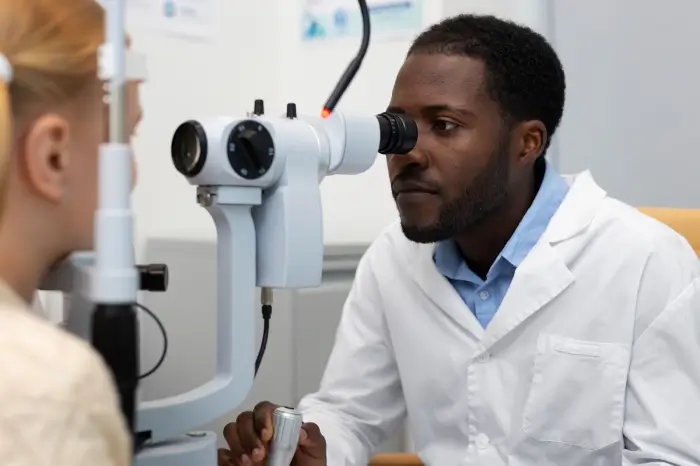Only for Licensed Professionals
Only for Licensed Professionals
.webp)
Tobradex For Conjunctivitis – Does It Work?
David Fuller
Last Updated On: September 4, 2025
Conjunctivitis, commonly referred to as pink eye, is a common inflammatory condition of the eye. In a Phase 3 clinical trial, a tobramycin–dexamethasone combination significantly helped reduce signs of blepharoconjunctivitis faster than azithromycin by day 8, demonstrating its effectiveness in relieving inflammation and discomfort associated with eye infections.
Tobra)Dex combines an antibiotic and a corticosteroid to tackle both bacterial infection and inflammation. Its dual-action formulation makes it a sought-after option—but we’ll keep the specifics reserved for later.
In this article, we will explore whether TobraDex is effective for conjunctivitis, how it works, when it’s appropriate to use, and what users should know before considering it.
Key Takeaways
- Tobradex combines tobramycin (antibiotic) and dexamethasone (corticosteroid), targeting both infection and inflammation in certain eye conditions.
- It may be prescribed for bacterial conjunctivitis with significant inflammation, but it is not appropriate for viral or allergic cases.
- Common bacterial causes include Staphylococcus aureus in adults and Haemophilus influenzae or Streptococcus pneumoniae in children. Tobramycin also covers Pseudomonas aeruginosa, relevant in contact lens–related disease.
- Correct dosage and proper tapering under medical supervision are vital to prevent resistance, side effects, or rebound inflammation.
- Risks include increased intraocular pressure, cataracts, secondary infections, and masking of underlying conditions like herpes simplex keratitis.
- Contraindications include viral, fungal, or mycobacterial eye disease, and patients should avoid contact lens use during treatment.
- A lack of improvement within 48 hours should prompt re-evaluation, and continued monitoring is recommended if treatment extends beyond 10 days.

Mechanism of Action of Tobradex in Treating Conjunctivitis

The effectiveness of Tobradex comes from the complementary actions of its two active ingredients:
- Tobramycin Component: An aminoglycoside antibiotic that binds to the 30S ribosomal subunit of susceptible bacteria, inhibiting protein synthesis. This prevents bacterial growth, leading to cell death. In bacterial conjunctivitis, common pathogens include Staphylococcus aureus in adults, and Haemophilus influenzae and Streptococcus pneumoniae in children. Tobramycin also has activity against Pseudomonas aeruginosa, which is particularly relevant in contact lens–related ocular infections.
- Dexamethasone Component: A potent corticosteroid that suppresses the inflammatory response by inhibiting the release of pro‑inflammatory mediators. This reduces redness, swelling, and ocular discomfort associated with infection‑related inflammation.
By combining targeted antimicrobial activity with inflammation control, Tobradex
Clinical Evidence on Tobradex Efficacy for Bacterial Conjunctivitis
In steroid-responsive cases where bacterial infection is confirmed or strongly suspected, combination therapies like Tobradex can improve inflammatory signs and symptoms. Evidence also supports its role in conditions like blepharoconjunctivitis, where studies have shown more rapid improvement in inflammation when compared with antibiotic-only regimens by day 8.
However, for uncomplicated acute bacterial conjunctivitis, clinical guidelines often recommend antibiotic monotherapy with careful follow-up, since steroids may mask symptoms and carry additional risks. The benefit of adding a corticosteroid in these mild cases is debated, and most experts prefer to reserve Tobradex for situations where inflammation is pronounced and may delay healing if untreated.
For patients, this means Tobradex may provide relief in certain scenarios but is not a universal option for all pink eye cases. Its value lies in carefully selected cases where addressing both infection and inflammation supports recovery.
Limitations and Risks of Tobradex Use in Non-Bacterial Cases
Tobradex cannot treat every form of conjunctivitis. When misused in viral or allergic cases, the medication not only fails to address the cause but can also pose risks.
Key Risks and Limitations
- Viral Conjunctivitis: Often caused by adenoviruses, this type does not respond to antibiotics. Steroids may worsen the condition by suppressing the immune response and prolonging recovery.
- Allergic Conjunctivitis: This form is best managed with antihistamines or avoidance of allergens. Tobradex does not target allergic pathways and may increase irritation if misused.
- Antibiotic Resistance: Using antibiotics unnecessarily contributes to bacterial resistance, reducing the effectiveness of future treatments.
- Steroid-related Side Effects: Dexamethasone can raise intraocular pressure, increase the risk of cataracts, or lead to secondary infections when used for long periods.
- Masking Disease: Corticosteroids may reduce redness and swelling temporarily, delaying recognition of underlying conditions like herpes simplex keratitis.
Tobradex is contraindicated in epithelial herpes simplex keratitis, vaccinia or varicella infections, mycobacterial eye disease, and fungal conditions of the eye. Patients should also avoid wearing contact lenses during treatment.
Because of these risks, Tobradex should only be prescribed after a professional evaluation and never obtained over the counter or used without guidance.
Patient Education and Monitoring When Using Tobradex for Conjunctivitis

Educating patients is crucial to ensure safe and effective use of Tobradex. Ophthalmologists stress that it is indicated for steroid-responsive inflammatory conditions with bacterial involvement, and misuse in viral or allergic cases can be harmful.
Practical Counseling Points
- Wash hands before applying drops or ointment to avoid introducing new bacteria.
- Shake the Tobradex suspension before each use for proper mixing of ingredients.
- Prevent contamination by keeping the dropper tip from touching the eye, lashes, or skin.
- Avoid contact lens wear during therapy, as lenses may worsen infection or irritation.
- Complete the full treatment course, even if symptoms improve quickly. Stopping too soon increases the risk of recurrence.
- Attend follow-up visits if treatment extends beyond 10 days, since healthcare professionals recommend intraocular pressure monitoring with corticosteroid use.
- If symptoms fail to improve within 48 hours, patients need re-evaluation to confirm the diagnosis or adjust therapy.
Patients should also be informed about the importance of proper tapering when steroids are used for more than a few days, rather than abrupt discontinuation. This prevents rebound inflammation and supports better outcomes.
In pediatric use, prescribing follows local labeling and the judgment of the treating physician, as long-term safety data are more limited.
By following these guidelines, patients can use Tobradex responsibly, maximizing its benefit while minimizing unnecessary risks. Correct Tobradex dosage and careful adherence are vital to successful treatment.
Conclusion
Tobradex for conjunctivitis can be highly effective in selected cases, particularly when inflammation is significant and bacterial infection is confirmed or strongly suspected. Its combination of tobramycin and dexamethasone addresses both infection and inflammation, offering a broader therapeutic effect than antibiotics alone.
Still, it is not appropriate for every type of pink eye. Viral and allergic conjunctivitis require different treatments, and misuse of Tobradex can introduce serious risks. Close medical supervision, accurate diagnosis, and patient education are what make this therapy safe and effective. With proper use, Tobradex remains a valuable option for managing bacterial conjunctivitis complicated by inflammation.
FAQs
1. Can Tobradex treat all types of conjunctivitis?
No. Tobradex is effective only in bacterial conjunctivitis with inflammation. It should not be used for viral or allergic forms.
2. How long does it take for Tobradex to work?
Patients may notice improvements in redness and discharge within a few days. If there is no improvement within 48 hours, reevaluation is necessary.
3. Are there side effects of Tobradex?
Yes. Possible effects include eye irritation, increased intraocular pressure, cataract formation, or secondary infection. Risk increases with prolonged use.
4. Can I use Tobradex without a prescription?
No. Tobradex is prescription-only and should only be used under professional guidance. Conjunctivitis has multiple causes, and correct diagnosis is necessary.
References
Torkildsen GL, Cockrum P, Meier E, Hammonds WM, Silverstein B, Silverstein S. Evaluation of clinical efficacy and safety of tobramycin/dexamethasone ophthalmic suspension 0.3%/0.05% compared to azithromycin ophthalmic solution 1% in the treatment of moderate to severe acute blepharitis/blepharoconjunctivitis. Curr Med Res Opin. 2011;27(1):171-178. doi:10.1185/03007995.2010.539603
Alfonso SA, Fawley JD, Alexa Lu X. Conjunctivitis. Prim Care. 2015;42(3):325-345. doi:10.1016/j.pop.2015.05.001
Tobradex: Uses, Dosage & Side Effects. Drugs.com. https://www.drugs.com/tobradex.html
Products
Cart
Log In
Newsletter
Subscribe for exclusive offers and updates on new arrivals
Share feedback at:
Working Hours
MON - SUN 9AM to 6PM EST
The Most Popular Brands
Med Supply Solutions
Support
Secure checkout is guaranteed with full adherence to PCI DSS payment standards.
Products listed here are guaranteed authentic and manufacturer-sourced.
Pay easily with trusted providers


*Google and Apple Pay are currently only available via a direct link provided by your account manager.
Copyright 2025. Med Supply Solutions